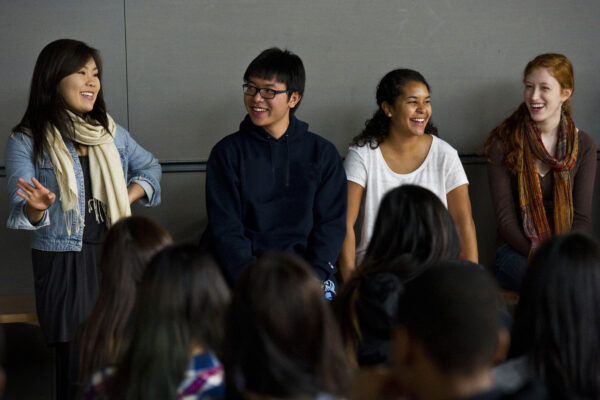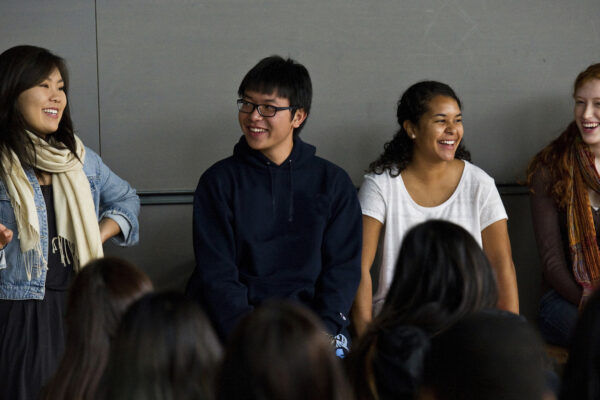By Nicole Roach
Four years ago, I was invited to serve as the first associate vice president for diversity and inclusion of Webster University, a private university on the outskirts of St. Louis. President Beth Stroble and Provost Julian Schuster were both quite confident that I could successfully lead this global institution towards enhanced commitment to diversity and inclusion—for students, faculty, and administration alike. Honored by the opportunity was an understatement.
On my first day, Sept. 30, 2013, I arrived full of humility and overflowing with vision. Not yet realizing the heavy load to come, I spent a nice amount of quality time mapping out what I thought were the most urgent priorities. I created what I called “The List,” which consisted of ideas, needs, theories, benchmarks, workshops, events, and website links. This was sure to be my roadmap to success.
I followed my masterminding and strategic planning with a listening tour. I had planned to visit with faculty, staff, students, and alumni within Webster University’s global network for the first three months. The following three months, I would position myself to meet individuals working in the diversity and inclusion field, in both the academy and corporate world. My goal was to determine needs, gaps, best practices, lessons learned, and strategy. This approach taught me a great deal.
I quickly realized that there was a lot of work to do to advance diversity and inclusion on the Webster campus. The greatest roadblock I discovered is that most people did not recognize that diversity and inclusion are not one phrase, but rather are two words with different meanings and different levels of significance. All too often remarks shared with me boiled around race, black and white in particular. Few of those conversations ever touched upon the idea of involvement and empowerment, the value, worth and dignity of all people, which is the core of inclusion. After many conversations to unpack the difference, I realized I needed to shift the direction of my efforts.
A New Tension: Ferguson
As I completed my first year, it seemed a good time to pull out “The List” so I could take stock of where we stood. But fate had a different course for me. On Aug. 9, 2014, Michael Brown, a teenager in Ferguson, a small community just 15 miles from my office, was shot to death by police. The protests followed hours later and quickly spread throughout the region. I experienced tension in Missouri like I’d never experienced before.
Initially I was stumped, somewhat paralyzed about how I could contribute to bring calm to our community. I found myself overtaken with emotions coupled with a sense of urgency to do something. And I did just that—I joined a group of black, brown and white people to march through the streets of St. Louis. Protesters took turns reading short biographies of African-Americans who have been killed in encounters with police, including Eric Garner and Michael Brown. I attended a couple of peaceful protests on the Webster campus as well.

Not long afterward, I stepped back to evaluate what had happened and how I responded. I realized I was uniquely positioned, having relationships with those in the streets, our students, faculty, staff, and leadership, both within our institution and the community at large. Having the ear of so many people gave me the chance to introduce the practice of reacting versus responding. Reacting and responding are similar terms, but they produce different outcomes. Reacting puts you on the defensive, with your emotions in control. Responding is a reaction that is thoughtful and contains a level of reasoning and logic. It was this formula that proved the value of having a chief diversity officer.
As the 2014-15 academic year began, I spent time listening to the concerns and needs of faculty, staff, and students. But this textbook approach did little to calm the energy in the air. It didn’t take many meetings for the Webster leadership to realize we needed to have some uncomfortable conversations.
And we did—both formally and informally, we took the time to listen to our community, covering topics including faculty development; recruiting more faculty and students of color; shifting the campus culture; inclusive curricular material and resources; and engaging students of color. This strategy was met with much resistance at all levels—people wanted action on these issues, not just talk. Even the responsibilities of my role, the chief diversity officer, were challenged.
It was a tough academic year, and our community collectively moved toward a deeper understanding of diversity and inclusion. While we understood the need to enhance diversity and inclusion, we didn’t comprehend the challenges we faced in communicating our commitment and our efforts. For example, the university’s administration would distribute statements enforcing the institutional commitment to diversity and inclusion. But the formal delivery of this message lacked empathy and connectivity. The community wanted more, and wanted it in a format they could relate to and directly respond to.
The solution was incorporating video messaging and more direct communication with the community. Through town hall forums, panel discussions, student group events, “lunch and learns,” faculty-led speaker series, working groups, school and college summits, and the launch of our annual diversity and inclusion conference, our Webster University community participated and responded to concerns raised by students, faculty, and staff. Conversations ultimately proved successful. Student groups, faculty and staff continue to present their concerns and challenges to our leadership so that we can continue to raise the bar of diversity and inclusion.

Pro Tip: Stop Casting the Net
After the protests calmed down, I spoke with many diversity and inclusion practitioners, sharing ideas about Webster’s approach to the community tension. One common idea I came across—and challenged—was the idea that having a campaign or strategy to recruit brown and black students ended when they enrolled. You have to build relationships with these students and their communities, which includes individuals and groups both inside and outside the walls of the institution.
All too often this challenge is addressed as if we are talking about casting a net, i.e. trying to capture specific numbers of similar-looking people. But we’re talking about human beings, each of whom are unique. Each person has their own likes and dislikes, their own specific needs, and their own views of the world around them. Yet academic institutions tend to categorize individuals into neat statistical packages that can easily be reported to the federal government in our IPEDS data.
So here lies one of the biggest mistakes that institutions repeat. We must understand that we can’t just go pitching tents and laying spirit swag across a tablecloth laced with school colors in brown and black neighborhoods and expect them to be excited about our presence. Inclusion starts before you get students, faculty, and staff on a campus. Ask yourself, “How are we showing up in the community? In the world? And have we earned their trust?”
Colleges and universities need to develop intentional, innovative ways to build relationships within these communities. I would also recommend we stop giving scholarships to black and brown students without any follow up with the student and their parents or guardians. I’m amazed how money and scholarships are handed out with limited communication, instruction, or programs to help with the transition into the academic community. We tend to forget that we are dealing with individuals, not statistics.
Essentially, I came to this realization that what is true for students also is true for recruiting faculty and staff: You can throw as much money as you want at minority communities to raise your numbers, but if your institution does not practice inclusion at all levels, those people will feel so uncomfortable or unwelcome in your offices and classrooms that they eventually will leave for someplace better.
Tearing Off the Band-Aids: Diversity is More Than Just Ethnicity
Entering my third year as a chief diversity officer, I had grown weary of band-aiding situations that would inevitably resurface. It was time to build a larger community of champions. I didn’t have to look far—I was soon approached by a group of students from the LGBTQ community, which made me pause and listen once again.
I honestly had to lean on them to educate me more on the acts of discrimination faced by their community and ideas for resolving them. But asking for help put me in a vulnerable state. They initially thought I was truly ignorant of my responsibilities. I was even challenged on my credentials and qualifications for holding the position of chief diversity officer. I shared with them that it was quite the opposite—I explained that it’s one thing to read about a topic and apply theory, but it’s another thing to sit with someone to learn of their personal experience(s) and hear their heart. These students—filled with concerns and passion about their needs—made me commit to changing my language, my strategy, my interactions, and everything I would do moving forward. I learned the history of the LGBTQ+ community, how they are discriminated against at all levels of society—right down to which bathrooms they are allowed to use—and the language they use to express their concerns.
Every event, every workshop, every speech, in everything I did, I became a connector and a collaborator. No longer would I, or others I worked with, build something without first conducting research. This meant exploring to see if what was being built actually met a need, which dispelled the myth that there is a one-size-fits-all solution. You cannot build something and expect it to work for all—even if the “all” are from the same self-identified group. This is all too true in the work of diversity and inclusion.
Moving Forward
Now in my fourth year, that listening tour I mentioned still continues, and I anticipate it continuing for the duration of my career. I remind others that the work of diversity and inclusion is not something we arrive at but a continuous journey which comes through building relationships. We’re so data driven, wanting to count and measure everything. This is not the proper formula. It’s the development of relationships that make the difference.
Remember “The List” I created? It’s still on my desk in a manila file folder. And not because it consisted of bad ideas. They’re actually pretty good ideas, but I didn’t need them for the first three years. Sometimes we can build things that are good for the future but not great for the present. When we step back and take the time to listen only then can we stop counting and start including.
As 2018 gets underway, I’m motivated in my efforts knowing the community of Webster University has made significant progress toward cultivating connections over calculating demographics. When you learn to court you won’t have to count; recruiting and retaining a diverse faculty, staff and student population will follow
If you have any questions or comments about this blog post, please contact us.


